1.3 Imperial System Conversion
1.3.1 Prep
Follow correct order of operations and evaluate the following
- [latex]10{(3)}^2[/latex]
- [latex]3\cdot2.54^2[/latex]
- [latex]7\cdot12^3[/latex]
- [latex]40\cdot\left(\frac14\right)^3[/latex]
- Spot the error! Explain in your own words the mistake made and correct it.
[latex]3\cdot4^2[/latex]
[latex]12^2[/latex]
[latex]144[/latex]
Reduce and multiply.
- [latex]\frac81\cdot\frac58[/latex]
- [latex]\frac{4.5}1\cdot\frac7{4.5}[/latex]
- [latex]\frac{10}1\cdot\frac35[/latex]
- [latex]\frac{12}1\cdot\frac56\cdot\frac75[/latex]
- [latex]\frac{15}8\cdot\frac87\cdot\frac74[/latex]
- [latex]\frac91\cdot\frac21\cdot\frac{11}1[/latex]
- [latex]\frac91\cdot\frac{10}3\cdot\frac53[/latex]
- [latex]\frac{25}4\cdot\frac25\cdot\frac25[/latex]
Find each of the following. Be sure to include correct units.
- The perimeter of the equilateral triangle
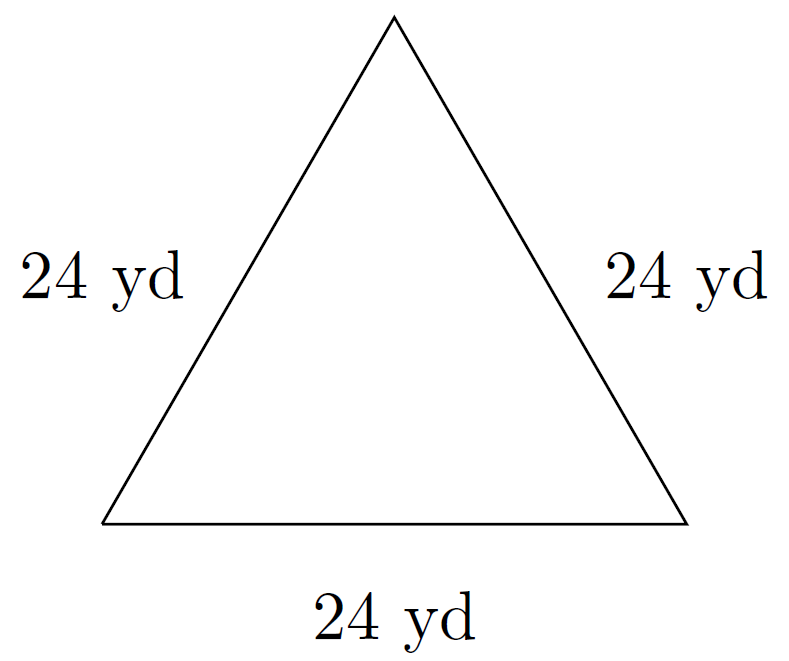
- The amount of fencing needed to enclose the
rectangle
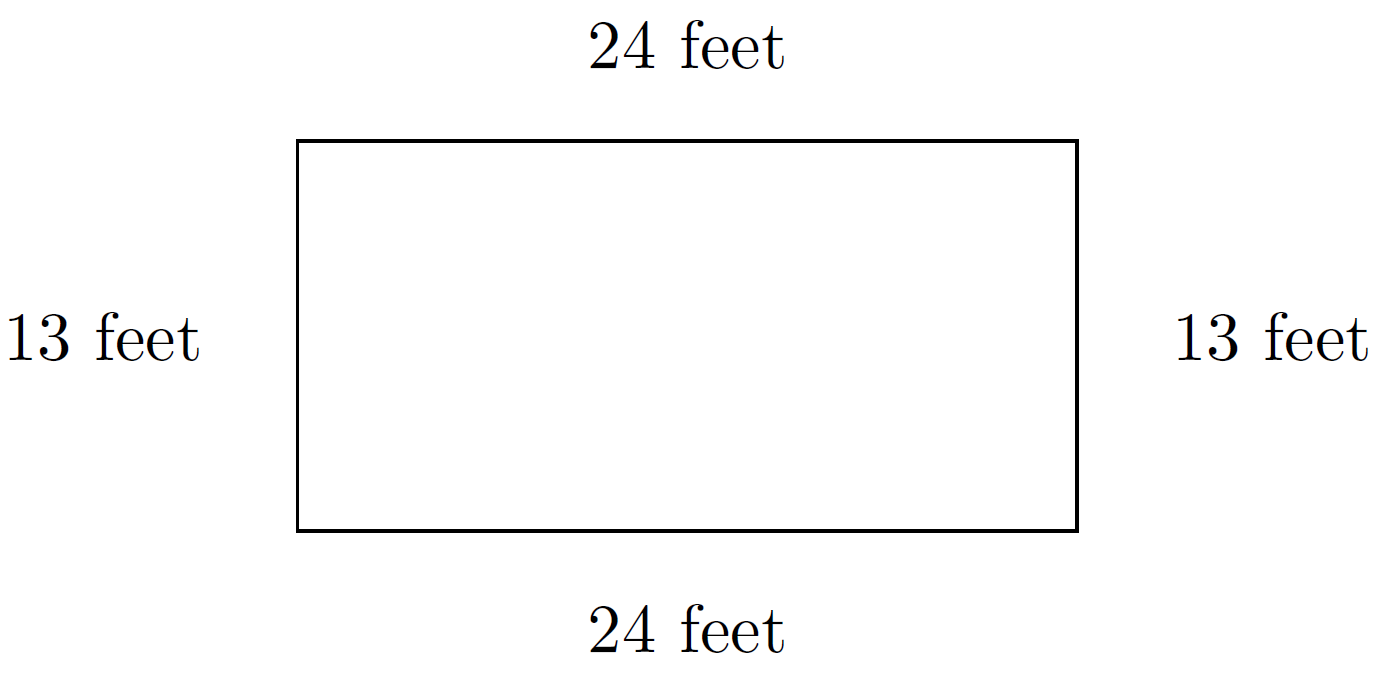
- The area of the square
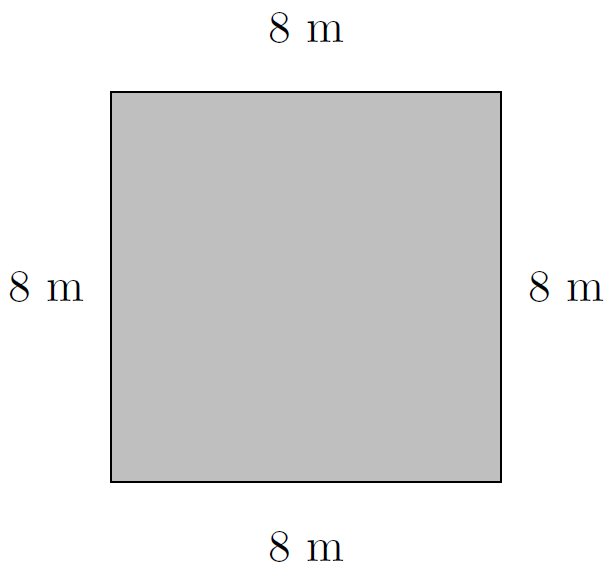
- The amount of grass needed to cover the rectangle
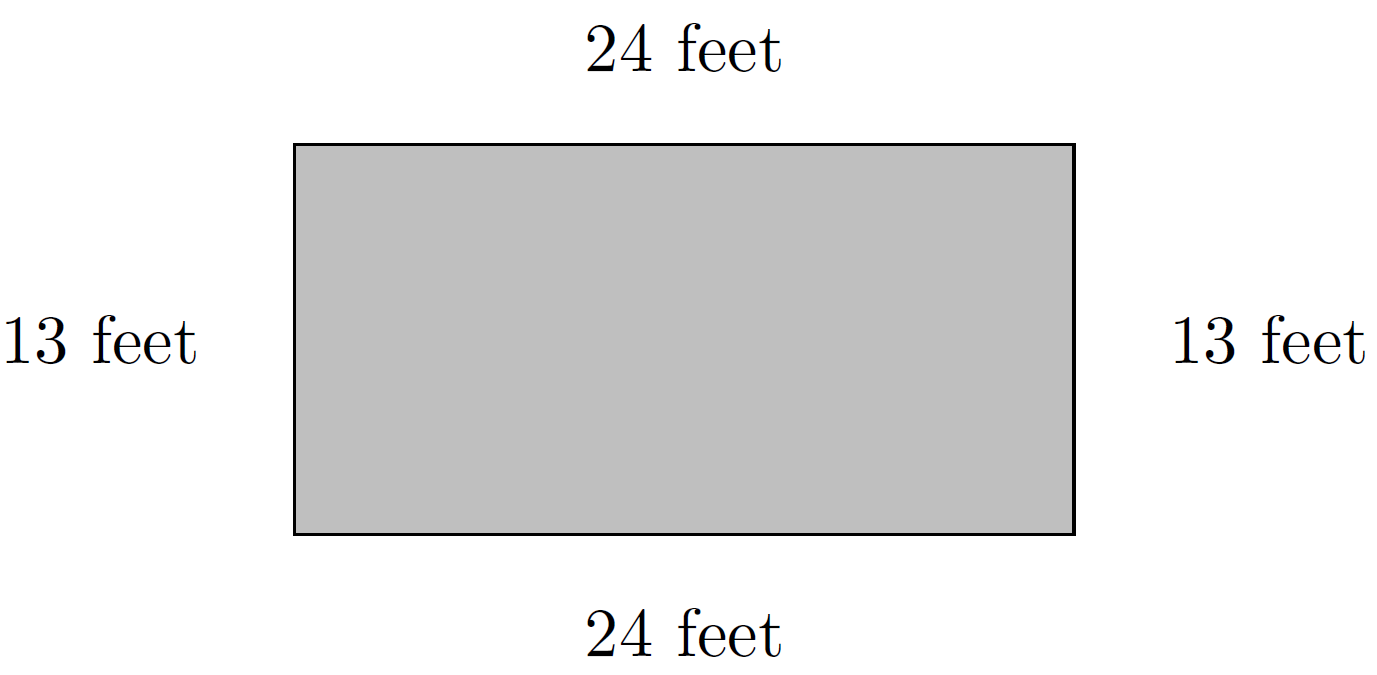
- The volume of the cube
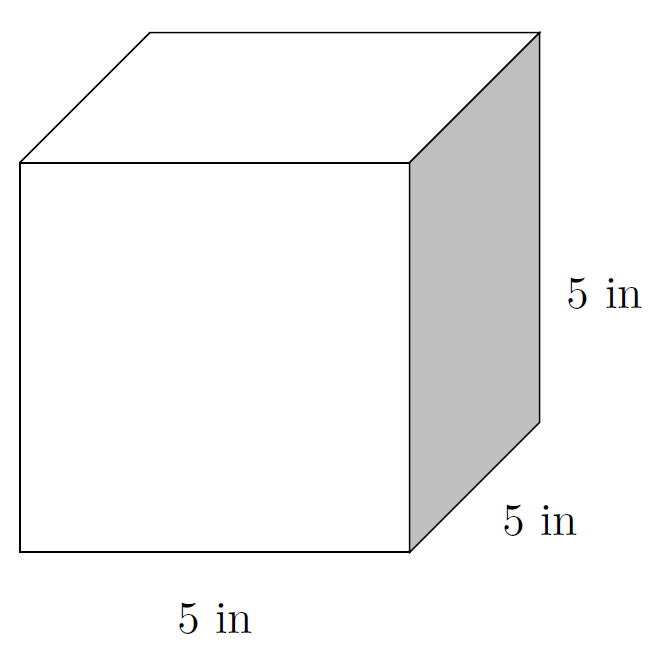
- The amount of sand needed to fill a box measuring 24 feet by 13 feet by 3 feet
- Which exponent indicates length? Area? Volume? Discuss.
Place a check mark in the columns that apply to each type of measurement.
| Length (distance) 1 dimension | Area 2 dimensions | Volume 3 dimensions | Mass | Time | Imperial (British) | Metric | |
|---|---|---|---|---|---|---|---|
| 1. cm | |||||||
| 2. [latex]cm^2[/latex] | |||||||
| 3. [latex]in^2[/latex] | |||||||
| 4. g | |||||||
| 5. hm | |||||||
| 6. dag | |||||||
| 7. years | |||||||
| 8. dL | |||||||
| 9. [latex]dam^2[/latex] | |||||||
| 10. [latex]mm^3[/latex] | |||||||
| 11. m | |||||||
| 12. mi |
Form a unit ratio for the following conversions. Identify whether the conversion is measuring length, area, or volume.
- [latex]1[/latex] inch =[latex]2.54[/latex] cm
- [latex]12[/latex] inches = [latex]1[/latex] foot
- [latex]1[/latex] foot = [latex]0.3048[/latex] m
- [latex]1\;mi^2=\;640\;{\text{acres}}[/latex]
- [latex]1\;L\;=\;0.001\;m^3[/latex]
- [latex]3[/latex] ft = 1 yd
- [latex]9\;ft^2\;=\;1\;yd^2[/latex]
- [latex]1\;oz\;=\;29.5735\;cm^3[/latex]
1.3.2 Preview
Example
The following example shows how to form a unit conversion.
Example.
Divide both sides by 1 ft.
We can use the result above to convert 3 feet to inches.
Try It!
How many minutes are in 24 hours?
Example
Consider the area of the rectangle below.
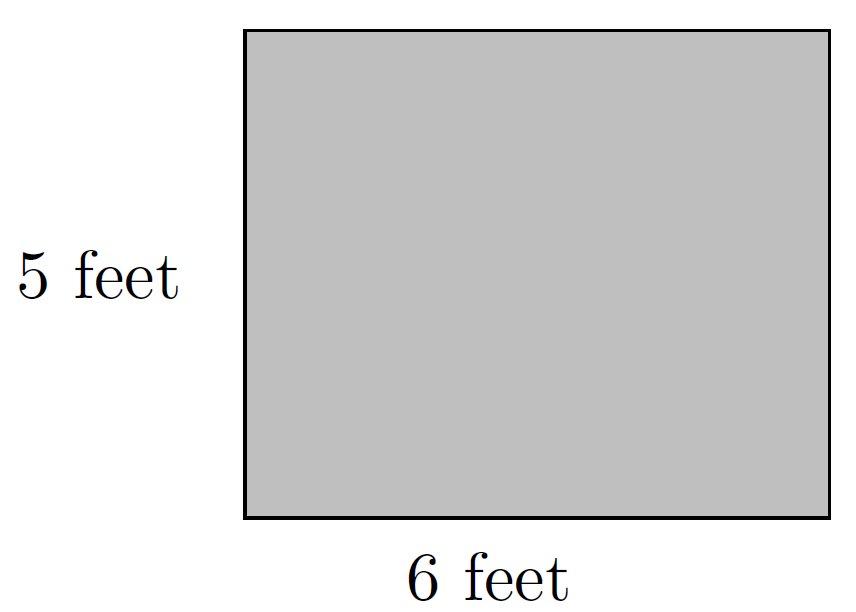
Area = (5 ft) (6 ft)
[latex]30\;ft^2[/latex]
To find the area in square inches, convert each side length to inches. Then multiply the results together.
[latex]\cancel{5\;ft}\cdot\frac{12\;in}{\cancel{1\;ft}}=\;60\;in[/latex]
[latex]\cancel{6\;ft}\cdot\frac{12\;in}{\cancel{1\;ft}}=\;72\;in[/latex]
Area = (60 in) (72 in)
4, 320 [latex]in^2[/latex]
Try It!
The volume of this cube is [latex]2\;ft\;\times\;2\;ft\;\times\;2\;ft\;=\;8\;ft^3[/latex]. What is its volume in cubic inches?
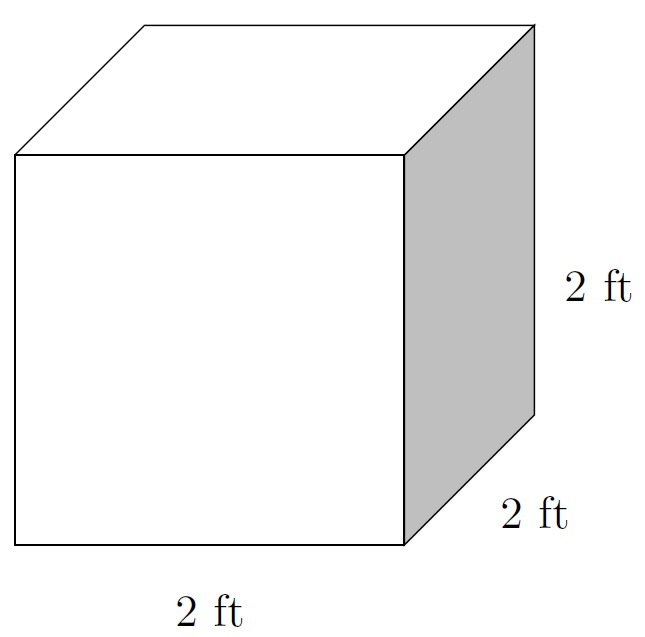
1.3.3 Classwork
Length
1 inch = 2.54 centimeters (cm)
1 foot = 12 inches
1 yard = 3 feet
1 mile = 5280 ft
1 foot = 0.3048 meters (m)
1 mile = 1.609344 kilometers (km)
Area
1 acre = 43, 560 square feet
1 square mile = 640 acres
1 square km = 100 hectares
Volume
1 US fluid ounce ≈ 29.57353 milliliters
1 liter ≈ 33.81402227 US fluid ounces
1 liter = 0.001 [latex]m^3[/latex]
1 US tablespoon = 3 US teaspoons
1 US cup = 16 US tablespoons
1 US cup = 8 US fluid ounces
1 US pint = 2 US cups
1 US pint = 16 US fluid ounces
1 US quart = 2 US pints
1 US gallon = 4 US quarts
1 US gallon = 3.78541178 liters
Mass and Weight (at sea level at Equator on Earth)
1 lb = 0.4536 kg
1 lb = 16 oz
Fill in the table real-life examples of the following measurements, and add more answers from your classmates.
| Measurement | Example |
|---|---|
| 1 inch | |
| 1 yard | |
| 1 mile | |
| 1 quart | |
| 1 fluid ounce | |
| 1 acre |
- Have you ever been shopping for jeans but didn’t want to try them on? Did you know you can use the length from the end of your fist to the end of your elbow to approximate your waist size? We can use our bodies in this manner to estimate other distances. For example, one knuckle is approximately one inch. Use your knuckle to estimate the length of two sheets of notebook paper in inches.
- Look at the packaging for any food or beverage of your choice. Write down the amount of the product that is given in both metric units and imperial units.
- Convert 72 inches to yards without using a calculator. Show all work.
Convert.
- 21.5 in = ___________________________________________________ cm
- 120 m = ___________________________________________________ yd
- 55 mi = ___________________________________________________ m
- 1.25 [latex]in^2[/latex] = _________________________________________________ [latex]cm^2[/latex]
- 1.07 acre = _________________________________________________ [latex]ft^2[/latex]
- 102 gal = ___________________________________________________ oz
- 96 oz = ___________________________________________________ lb
- 0.5 [latex]ft^3[/latex] = __________________________________________________ [latex]in^3[/latex]
- 3 days = ___________________________________________________ sec
- [latex]1.98\;\times\;10^8[/latex] seconds = ____________________ years and months
- 88 inches per second into miles per day
- 12,080 gallons per week into liters per hour
- 186,282 miles per second into meters per second
- If a certain model of Volkswagen gets 11.48 km/L in Europe, is this considered good gas mileage in the U.S.? Justify your answer.
Perform conversions to answer the following.
- Convert 50 years into seconds. Express your answer in scientific notation.
- Mary is painting a rectangular wall that measures 3 meters by 7 meters. She wants to find the area of the wall in square feet.
- At a given point in its orbit, the moon is [latex]2.4\times10^5[/latex] miles from the earth. How long does it take light from a source on the earth to reach a reflector on the moon and return? (Speed of light is [latex]3.0\times10^8\;m/s.[/latex] )
- The following have to do with area conversions.
- Draw a rectangle that has an area of 12 [latex]ft^2[/latex].
- Convert the area of your rectangle to [latex]in^2[/latex].
- Do the side lengths you chose for your rectangle affect your answer for part (b)? Explain.
- To lay down carpet in a room that is 10 feet by 11 feet, how many square inches of carpet do you need?
- Steve can run a mile in 12 minutes. How many feet can he run per second?
- Mat fills his bathtub at a rate of 0.4 liters per second. Brooke fills her bathtub at a rate of 25 quarts per minute. Which bathtub fills at a faster rate? Show your work to explain why.
- A baby is born weighing 3.46 kg. Convert this to pounds and ounces.
Reference Page
Metric Prefixes
| Prefix | Mega- | Kilo- | Hecto- | Deka- | Unit | Deci- | Centi- | Milli- | Micro- |
|---|---|---|---|---|---|---|---|---|---|
| Abbreviation | M | k | h | da | m, g, L | d | c | m | [latex]\mu[/latex] |
| No. of units | 1,000,000 | 1,000 | 100 | 10 | 1 | [latex]\frac1{10}[/latex] | [latex]\frac1{100}[/latex] | [latex]\frac1{1000}[/latex] | [latex]\frac1{1000000}[/latex] |
| Power of 10 | [latex]10^6[/latex] | [latex]10^3[/latex] | [latex]10^2[/latex] | [latex]10^1[/latex] | [latex]10^0[/latex] | [latex]10^{-1}[/latex] | [latex]10^{-2}[/latex] | [latex]10^{-3}[/latex] | [latex]10^{-6}[/latex] |
Conversions
Length
1 inch = 2.54 centimeters (cm)
1 foot = 12 inches
1 yard = 3 feet
1 mile = 5280 ft
1 foot = 0.3048 meters (m)
mile = 1.609344 kilometers (km)
Area
1 acre = 43, 560 square feet
1 square mile = 640 acres
1 square km = 100 hectares
Volume
1 US fluid ounce ≈ 29.57353 milliliters
1 liter ≈ 33.81402227 US fluid ounces
1 liter = 0.001 [latex]m^3[/latex]
1 US tablespoon = 3 US teaspoons
1 US cup = 16 US tablespoons
1 US cup = 8 US fluid ounces
1 US pint = 2 US cups
1 US pint = 16 US fluid ounces
1 US quart = 2 US pints
1 US gallon = 4 US quarts
1 US gallon = 3.78541178 liters
Mass and Weight (at sea level at Equator on Earth)
1 lb = 0.4536 kg
1 lb = 16 oz
1.3.4 Homework
Convert.
- 10 km = __________________ mi
- 120 g = _________________ [latex]\mu g[/latex]
- 2.40 mi = _______________ ft
- [latex]17.0\;in^2=[/latex] _________________ [latex]cm^2[/latex]
- 0.850 qt = _________________ mL
- 61.0 cm = _____________ ft
- 5L = ____________ pt
- 10.0 in = _______________ cm
- 320 oz = _______________ ib
- 1 year = _______________ min
- 120 m = _______________ yd
- [latex]2.4\;mi^2\;=[/latex] _______________ [latex]ft^2[/latex]
- 102 gal = _____________ [latex]in^3[/latex]
- [latex]150\;m^3\;=[/latex] _________________ [latex]ft^3[/latex]
- 1950 g = ________________ ib
- 1.2 kg = ________________ oz
- 2L = _________________ pt
- 725 ft = _______________ m
- 95 L = ________________ gal
- 60 mph = ________________ m/s
- [latex]5.93\;cm^3=[/latex] _______________ [latex]m^3[/latex]
- [latex]1\;ft^3=[/latex] ____________________ [latex]m^3[/latex]
- [latex]1.42\;g/cm^2\;=[/latex] __________________ [latex]mg/mm^2[/latex]
- [latex]8.24\;g/cm^2=[/latex] ____________________ [latex]mg/mm^2[/latex]
Perform the following conversions to answer the following.
- Convert 10,000 meters to miles two different ways.
- When converting from [latex]ft^2[/latex] to [latex]mi^2[/latex], explain what it means to use the unit conversion twice.
- Usain Bolt, the fastest recorded human, has been clocked at 12.43 meters per second. A student performs the following conversion into miles per hour (12.43)(0.3048)(5,280)(60)(60) = 72,014,925.3 mph
- Is this answer reasonable?
- Explain in your own words the errors made.
- What is the correct answer in miles per hour?
- 130 meters per second into miles per hour
- 1100 feet per second into miles per hour
- 53 yards per hour into inches per week
- 721 lb per week into kg per second
- A regulation pitcher’s mound is [latex]10\frac12[/latex] inches off the ground. Which of the following would be an appropriate alternative unit of measurement for this distance?
- Centimeters
- Feet
- Kilometers
- Grams
- Miles
- The distance from a Port Huron to the Indiana State line is approximately 281 miles (via I-94). Express this distance in kilometers.
- A baby born in the US weighs 3.485 kg according to the scale in the birthing room. Convert this to pounds and ounces so you can tell the grandparents how much the baby weighed.
- Nick Cave’s new movie is titled 20,000 Days on Earth. How old is Nick if the title was correct that he has been alive for 20,000 days (in years and months)?
- How many years old are you if you have lived 1 billion seconds?
- The length of a football field is 100 yards. Which of the following is an equivalent measurement? (More than one answer may be correct.)
- 300 feet
- 100 meters
- 9,144 centimeters
- 914.4 meters
- 10,000 centimeters
- A gallon of chocolate milk sells for $3.14. A snack-size bottle of chocolate milk sells for 3 cents per ounce. Which is a more economical purchase? Show your work to explain why.
- If you travel 65 mph, how many feet can you travel in 22 minutes?
- A child requires a 4.5 mL dose of medicine each day. How many days would a cup of this medicine last?
- San Antonio is 465 [latex]mi^2[/latex]. Houston is [latex]1,623.92\;km^2[/latex]. Which city is bigger and by how much?
- Scientists estimate the total amount of fresh water on earth to be [latex]3.73\;\times\;10^8\;km^3[/latex]. What is this volume in cubic meters? In liters? [latex](1\;{\text{liter}}\;=\;0.001\;m^3)[/latex]
- How many years old are you if you have lived 1 trillion seconds?
- 1 mL of ink can print 50 pages of text. If you had 5 gallons of ink then how many pages could you print?
- At his annual physical, Tony measured 6 feet, 2 inches tall. How many centimeters tall is he?
- The pediatrician tells the parents that their child is 92 centimeters tall. How tall is the child in feet and inches?
- A newborn baby is 53 centimeters long. How many inches long is she?
- A patient weighs 56 pounds. How many kilograms does she weigh?
- Last year Daniel donated 1892.72 milliliters of blood. If a person donates 1 pint each time, how many times did Daniel donate blood last year?
For the next two problems, use the dosage instructions in the following table.
Age (years) Weight (lb) Dose Under 4 Under 36 Do not use 4–5 36–47 1 tsp 6–11 48–95 2 tsp 12–Adult Over 95 1 Tbsp - If a child, age 4, weighs 36 pounds, how many milliliters of medicine will he take per dose?
- If a child, age 12, weighs 105 pounds, how many milliliters of medicine will she take per dose?
- Blood makes up 7% of a body’s weight. If a person weighs 175 lb, how much would his blood weigh? Provide the answer in both pounds and kilograms.
- The average body has 10 pints of blood. How many ounces of blood are in a body?
- Using your answer from 68, how many mL of blood are in the body?
- How many [latex]cm^3[/latex] (cc) are in [latex]\frac12[/latex] tsp?
- How many qt are in 4 fl oz?
- Convert 0.05 g to [latex]\mu g[/latex]
- Convert 0.0025 L to [latex]cm^3[/latex] (cc).
- How many tsp are in 2 Tbsp?

